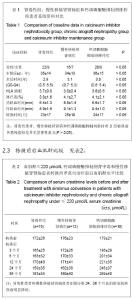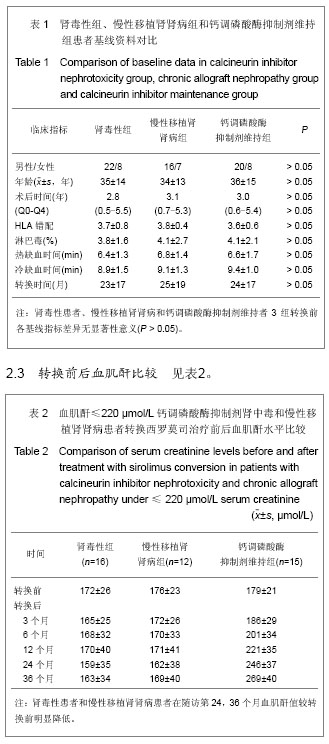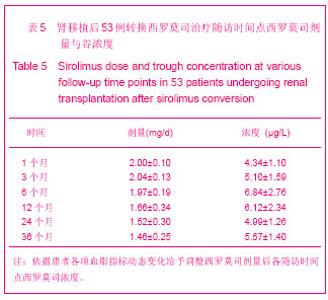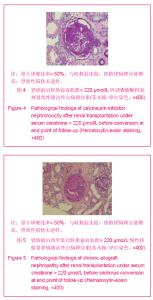Chinese Journal of Tissue Engineering Research ›› 2013, Vol. 17 ›› Issue (53): 9164-9171.doi: 10.3969/j.issn.2095-4344.2013.53.011
Previous Articles Next Articles
Sirolimus alternative for calcineurin inhibitor in treatment of nephrotoxicity and chronic allograft nephropathy
Wang Zhi-gang1, Feng Gui-wen1, Li Jin-feng1, Shang Wen-jun1, Pang Xin-lu1, Cui Zhi-li2, Liu Lei1, Xie Hong-chang1, Feng Yong-hua1, Guo Zhan3
- 1Department of Kidney Transplantation, First Affiliated Hospital of Zhengzhou University, Zhengzhou 450052, Henan Province, China; 2Department of Pediatrics, Third Affiliated Hospital, Zhengzhou University, Zhengzhou 450052, Henan Province, China; 3Department of Urinary Surgery, First Affiliated Hospital, Zhengzhou University, Zhengzhou 450052, Henan Province, China
-
Revised:2013-09-03Online:2013-12-31Published:2013-12-31 -
Contact:Feng Gui-wen, Professor, Chief physician, Master’s supervisor, Department of Kidney Transplantation, First Affiliated Hospital of Zhengzhou University, Zhengzhou 450052, Henan Province, China fengguiwen@hotmail.com -
About author:Wang Zhi-gang★, Studying for master’s degree, Department of Kidney Transplantation, First Affiliated Hospital of Zhengzhou University, Zhengzhou 450052, Henan Province, China zhigang2012@126.com -
Supported by:the National Natural Science Foundation of China, No. U1204820*
CLC Number:
Cite this article
Wang Zhi-gang, Feng Gui-wen, Li Jin-feng, Shang Wen-jun, Pang Xin-lu, Cui Zhi-li, Liu Lei, Xie Hong-chang, Feng Yong-hua, Guo Zhan . Sirolimus alternative for calcineurin inhibitor in treatment of nephrotoxicity and chronic allograft nephropathy[J]. Chinese Journal of Tissue Engineering Research, 2013, 17(53): 9164-9171.
share this article
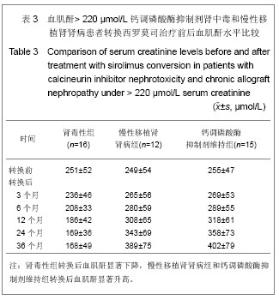
患者血肌酐≤220 μmol/L:各组转换前血肌酐值差异无显著性意义(P > 0.05);肾毒性患者和慢性移植肾肾病患者在随访第24,36个月血肌酐值较转换前明显降低(P < 0.05);钙调磷酸酶抑制剂维持组血肌酐缓慢爬行升高,高于西罗莫司转换组,差异有显著性意义(P < 0.05)。 患者血肌酐> 220 μmol/L:各组转换前血肌酐值差异无显著性意义(P > 0.05);肾毒性组血肌酐由转换前至转换后显著下降;慢性移植肾肾病患者、钙调磷酸酶抑制剂维持组由转换前至转换后显著升高;3组在随访的6,12,24,36个月血肌酐值与转换前比较差异有显著性意义(P < 0.05);慢性移植肾肾病、钙调磷酸酶抑制剂维持组各随访时间点比较,差异无显著性意义(P > 0.05);见表3。"

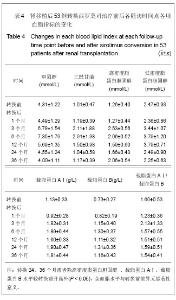
2.4 转换前后蛋白尿情况 血肌酐≤220 μmol/L患者:肾毒性组和慢性移植肾肾病组转换前尿常规白蛋白为“+”,1例,转换后转阴,新增尿白蛋白“++”,1例,在慢性移植肾肾病组,加用雷公藤苷后转阴[9]。 血肌酐> 220 μmol/L患者:肾毒性组和慢性移植肾肾病组转换前尿常规白蛋白为“+”,2例,转换后均未转阴,新增尿白蛋白“+++”,3例,钙调磷酸酶抑制剂肾中毒组1例,慢性移植肾肾病组4例。 4组共6例(11.3%),调整降压药为血管紧张素转换酶抑制剂和(或)血管紧张素受体拮抗剂加用雷公藤苷后2例转阴。 2.5 转换后高脂血症 转换西罗莫司后1年内高脂血症发生率为45.3%(24/53),其中高胆固醇、三酰甘油血症和混合型高脂血症发生率分别为39.6%(21/53)、30.2%(16/53)、13.2%(7/53)。40例高密度脂蛋白胆固醇、48例低密度脂蛋白胆固醇升高达到或超过正常上线值,发生率分别为:75.5%、58.5%;西罗莫司浓度与胆固醇、三酰甘油的相关系数分别为0.391(P < 0.001)、0.336(P < 0.01)。 西罗莫司引起高脂血症变化具有一定规律性:转换西罗莫司后1个月除三酰甘油、载脂蛋白(载脂蛋白AⅠ/载脂蛋白B)外余血脂指标明显上升变化趋势相似,三四个月达到最高峰,五六个月开始回落,但仍高于转换前水平;转换后1个月、三四个月、五六个月3组血脂水平差异有显著性意义(P < 0.05)。三酰甘油呈缓慢上升趋势,转换后五六个月达到最高峰,转换1,3,6,12个月后各时间点与转换前差异有显著性意义(P < 0.05)。载脂蛋白AⅠ/载脂蛋白B转换后1个月高于余时间点(P < 0.05),余时间点差异无显著性意义。 通过检测西罗莫司浓度基础上适当减少西罗莫司的剂量,同时按照“高脂血症健康教育”中提出的改善生活方式和饮食治疗要求进行日常生活管理;达到高脂血症治疗标准的使用他汀类和(或)贝特类降脂药物后血脂水平均降至正常或稍高于正常[10]。转换24,36个月患者除高密度脂蛋白胆固醇、载脂蛋白AⅠ、载脂蛋白B水平较转换前升高外(P < 0.05),余血脂水平与转换前差异无显著性意义(P > 0.05),详见表4,5。"
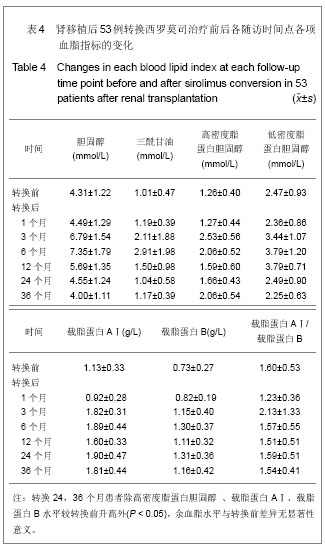
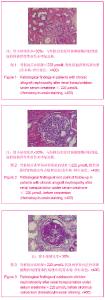
维持组1年内高脂血症发生率为14.3%(4/28),明显低于西罗莫司转换组,差异有显著性意义(P < 0.05)。 2.6 其他不良事件发生情况 西罗莫司转换受者53例中发生急性排斥反应2例(3.8%);维持受者28例发生急性排斥反应1例(3.6%),均发生在转换后6个月内,为临床诊断,未经活检证实,经甲泼尼龙200 mg冲击后均逆转。转换治疗应用西罗莫司随访过程中肺部感染6例(11.3%),给予敏感抗生素等应用后治愈。高尿酸血症14例(26.4%),肝功能异常11例(20.7%),白细胞减少12例(22.6%),血小板减少9例(17.0%),贫血16例(30.2%)。维持组随访过程中肺部感染6例(11.3%),治愈。高尿酸血症6例(21.4%),肝功能异常4例(14.3%),白细胞减少3例(10.7%),贫血7例(25.0%),上述不良事件发生后给予相应治疗均治愈或好转,未达到排除标准。 2.7 转换西罗莫司人、肾存活率 纳入患者57例,随访3年中,均存活。慢性移植肾肾病组共有4例血肌酐呈进行性上升翻倍,其中2例返回透析治疗,2例移植肾摘除,退出研究。西罗莫司转换治疗3年人肾存活率分别为100%和93.0%。 2.8 随访终点穿刺活检 血肌酐≤220 μmol/L肾毒性组和钙调磷酸酶抑制剂维持组,血肌酐> 220 μmol/L肾毒性组,随访36个月末穿刺活检各2例,病理表现部分肾小管萎缩、空泡样变和间质轻度增生、纤维化、肾小球硬化,硬化率<30%;与转换前比较钙调磷酸酶抑制剂造成的移植肾毒性损伤未明显进展。见图1,2。 血肌酐≤220 μmol/L慢性移植肾肾病组和钙调磷酸酶抑制剂维持组,血肌酐> 220 μmol/L钙调磷酸酶抑制剂维持组穿刺活检各1例,主要表现为部分肾小动脉管壁增厚透明样变性、管腔变窄、肾小球硬化、肾小管萎缩和间质纤维化,符合B、T淋巴细胞介导的慢性排除反应和Ⅲ级慢性移植肾肾病改变,肾小球硬化率>50%。与转换前比较移植肾病理分级增高,未逆转钙调磷酸酶抑制剂造成的移植肾毒性损伤。见图3-5。"
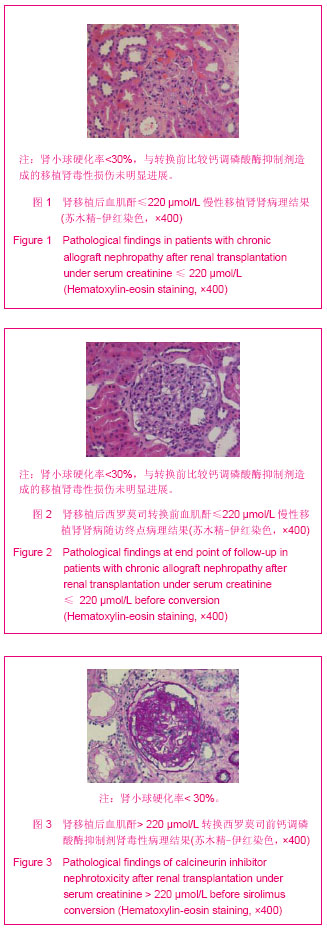
| [1] LiL,Sun Q.Renal transplantation in China:ten years of experience at Nanjing Jinling Hospital.Clin Transpl.2006: 71-77.[2] Tomasoni S.Remuzzi Q Benigni A.Allograft rejection:acute and chronic studies.Contrib Nephrol.2008;159:122-34.[3] 季曙明,文吉秋,黎磊石,等.西罗莫司对肾移植受者的转换治疗[J]. 中国组织工程研究与临床康复,2009,13(31):6018-6022.[4] De Mattos AM,Olyaei AJ,Bennett WM.Nephrotoxicity of immunosuppressive drugs:long-term consequences and challenges for the future.Am J Kidney Dis.2000:35(2): 333-346.[5] 文吉秋,季曙明.雷帕霉素减轻神经钙蛋白抑制剂的肾毒性[J].肾脏病与透析肾移植杂志,2007,16(3):283-288.[6] Saber LT,Ikeda MY,Almeida JM.Posttransplantation conversion to sirolimus-based immunosuppression:a single center experience Transplant Proc,2007,39:3098-3100.[7] Racusen LC, SolezK, Colvin RB, et al.The Banff 97 working classification of renal allograft pathology.Kidney Int.1999;55 (2): 713-723.[8] 丰贵文,李金锋,王跃,等.西罗莫司替换钙调磷酸酶抑制剂治疗老年亲属供肾移植受者移植肾功能减退的疗效[J].器官移植,2011, 2(4):194-196.[9] Ji SM,Li LS,Wen JQ,et al.Therapeutic effect of Tripterygium wilfordii on proteinuria associated with sirolimus in renal transplant recipients.Transplant Proc.2008;40(10):3474-3478.[10] 中华心血管病杂志编委会.血脂异常防治建议[J].中华心血管病杂志,1997,25(3):169-175.[11] Yates PJ,Nicholson ML.The aetiology and pahogenesis of chronic allograft nephropathy.Transplant Immunol.2006; 16: 148-157.[12] Nankivell BJ,Borrows RJ,Fung CL,et,al.Calcineurin inhibitor nephrotoxicity:Iongitudinal assessment by protocol histology. Transplantation,2004,78:557-565.[13] Nankivell BJ, Borrows RJ, Fung CL,et al.Calcineurin inhibitor nephrotoxicity:longitudinal assessment by protocol histology. Transplatation,2004,78(4):557-565.[14] Helal I,Chan L.Steroid and calcineurin inhibitor-sparing protocols in kidney transplantation.Transplant Proc,2011; 43(2): 472-477.[15] Diekmann F,Campistol JM.Covension from calcineurin inhibitor to sirolimus in chronic allograft nephropathy:benefits and risks.Nephrol Dial Transplant.2006;21(3):562-568.[16] Diekmann F,Badde K,Oppenhermer F,et al.Predictors of success in convension from calcineurin inhibitors to sirolimus in chronic allografl dysfunction.AM J Transplantation. 2004; 4(11):1869-1875.[17] Weber T,Abendroth D,Schelzing H.Rapamycin rescue therapy in patients afrer kidney transplantation:first clinical experience.Transpl Int.2005;18(2):151-156. [18] Bumbea V,Kamar N,Ribes D,et al.Long-term results in renal transplant patients with allcgraft dysfunction after switching from calcineurin inhibitors to sirolimus.Nephrol Dial Transplant. 2005;20(11):2517-2523.[19] Bosmans JL,Ysebaert DK.Verpooten GA.Chronic allograft nephropathy:what have we learned from protocol biopsies?Transplantation.2008;85(7 Supl):S38-S41.[20] Citterlo F,Scata MC,Violi P,et al.Rapid conversion to sirolimus for chronic progressive deterioration of the renal function in kidney allograft recipients. transplant:Proc.2003; 35(4): 1292-1294.[21] Coombes JD,Mreich E,Liddle C,et al.Rapamycin worsens renal function and intratubular cast formation in protein overload nephropathy.Kidney Int.2005;68(6):2599-2607.[22] Letavernier E,Peraldi MN,Pariente A,et,al. Proteinuria following a switch from calcineurin inhibitor to sirolimus. Transplantation.2005;80(9):1198-2203.[23] Arellano EM,Campistol JM,Oppenheimer F,et al.Sirolimus monotherapy as maintenance immunosuppression: single-center experience in 50 kidney transplant patients. Transplant Proc.2007;39(7):2131.2134.[24] 惠氏专栏.310试验中早期使用西罗莫司并撤除环孢素A并不导致蛋白尿增加[J].中华器官移植杂志,2008,29(7):448.[25] MacDonald AS ,for the Rapamune Global Study Group.A worldwide phaseⅢrandomized,controlled,safety and efficacy study of a sirolimus/cyclosporine regimen for prevention of acute rejection in recipients of primary mismatched renal allografts.Transplantation.2001;71:271.[26] 曾章新,谭建明.肾移植患者血脂紊乱对移植肾功能的影响[J].国外医学泌尿系统分册,2005,32:217-220.[27] Asberg A,hartmann A,Fjeldsa E,et aI. AtorvGOTatinimproves endothelial function in renal transplant recipients.Nephrol Dial Transplant.2001;16:19-20.[28] 叶平.血脂的基础与临床[M].北京:人民军医出版社,2002:205.[29] 王长希,尚文俊,陈立中,等.雷帕霉素对肾移植受者血脂的影响[J].肾脏病与透析肾移植杂志,2004,13(3):222-225.[30] MacDonald A,Scarola J,BurkeJT,et al.Clinical pharmacokinetics And the rapeutic drug monitoring of sirolimus. Clin Ther.2000;22 (suppl B):101-121.[31] 陆莉,林志彬.一种新型的免疫抑制剂——雷帕霉素[J].中国药学杂志,2001,36(9):643-545.[32] 季曙明,文吉秋,沙国柱,等.西罗莫司对肾移植受者的转换治疗[J].中国组织工程研究与临床康复,2009,13(31):6018-6022. |
| [1] | Zhu Ning, Yang Xinming, Ruan Jianwei. Triptolide improves spinal cord injury recovery via upregulation of autophagy and inhibition of apoptosis in Thy-yfp transgenic mice [J]. Chinese Journal of Tissue Engineering Research, 2020, 24(在线): 1-. |
| [2] | Liao Yuan, Qu Mengjian, Liu Jing, Zhong Peirui Zeng Yahua, Wang Ting, Xiao Hao, Li Lan, Liu Danni, Yang Lu, Zhou Jun. Effects of ultrashort wave on inflammatory response in rats with acute lung injury [J]. Chinese Journal of Tissue Engineering Research, 2020, 24(在线): 2-. |
| [3] | Kong Desheng, He Jingjing, Feng Baofeng, Guo Ruiyun, Asiamah Ernest Amponsah, Lü Fei, Zhang Shuhan, Zhang Xiaolin, Ma Jun, Cui Huixian. Efficacy of mesenchymal stem cells in the spinal cord injury of large animal models: a meta-analysis [J]. Chinese Journal of Tissue Engineering Research, 2020, 24(在线): 3-. |
| [4] | Li Xiaoqun, Xu Kaihang, Ji Fang. Corylin inhibits osteoclastogenesis and attenuates postmenopausal osteoporosis in mice [J]. Chinese Journal of Tissue Engineering Research, 2020, 24(在线): 4-. |
| [5] | Zhang Shuang, Xu Xiaomei, Zeng Yang, Yuan Xiaoping, Lin Fuwei. Rev-erbα’s effect on osteoblastogenesis of mouse bone marrow mesenchymal stem cells [J]. Chinese Journal of Tissue Engineering Research, 2020, 24(31): 4921-4926. |
| [6] | Xun Chong, Wang Qiang, Li Changzhou, Liu Xiaofeng. Potential molecular targets and therapeutic mechanisms underlying transplantation of autologous bone marrow stem cells for the treatment of spinal cord injury based on bioinformatics [J]. Chinese Journal of Tissue Engineering Research, 2020, 24(31): 4927-4933. |
| [7] | Chen Jia, Yang Yiqiang, Hu Chen, Chen Qi, Zhao Tian, Yong Min, Ma Dongyang, Ren Liling. Fabrication of prevascularized osteogenic differentiated cell sheet based on human bone marrow mesenchymal stem cells and human umbilical vein endothelial cells [J]. Chinese Journal of Tissue Engineering Research, 2020, 24(31): 4934-4940. |
| [8] | Liao Jian, Huang Xiaolin, Zhou Qian, Huo Hua, Qi Yuhan, Wu Chao, Shi Qianhui, Yang Tongjing, Liao Yunmao, Liang Xing. Calcined bone/chitosan composite promotes osteogenic differentiation of bone marrow mesenchymal stem cells in Sprague-Dawley rats [J]. Chinese Journal of Tissue Engineering Research, 2020, 24(31): 4941-4947. |
| [9] | Wang Guoliang, Li Yanlin, Xiang Yaoyu, Jia Di, Li Canzhang, He Lu. MicroRNA expression profiles of chondrocytes in osteoarthritis induced by stromal cell derived factor 1 [J]. Chinese Journal of Tissue Engineering Research, 2020, 24(31): 4948-4953. |
| [10] | Li Yuanqi, Lin Hai, Luo Hongrong, Zhang Xingdong. Relationship between mitochondrial autophagy and chondrogenesis of bone marrow mesenchymal stem cells [J]. Chinese Journal of Tissue Engineering Research, 2020, 24(31): 4954-4960. |
| [11] | Liu Hao, Liu Jun, Rui Yongjun, Tang Fenglin, Lu Miao, Ding Tao. Co-transfection by Nell-1 and Noggin-shRNA promotes osteoblast differentiation of adipose derived mesenchymal stem cells [J]. Chinese Journal of Tissue Engineering Research, 2020, 24(31): 4966-4970. |
| [12] | Wei Renyue, Li Xuechun, Li Yan, Yu Yang, Zhang Yu, Liu Zhonghua. A serum-free monolayer method for differentiation of porcine induced pluripotent stem cells into vascular endothelial cells [J]. Chinese Journal of Tissue Engineering Research, 2020, 24(31): 4971-4978. |
| [13] | Gu Yubo, Zhang Dongliang, Yuan Wei, , Song Lujie. Exosomes from adipose-derived stem cells can promote cavernous nerve regeneration in rats [J]. Chinese Journal of Tissue Engineering Research, 2020, 24(31): 4979-4985. |
| [14] |
Zheng Haijun, Jin Hui, Cui Hongling, Zhu Yakun, Zeng Hui, Han Fengjie, Qiu Cuiting, Liu Jing.
Safety of drug-coated balloon versus drug-eluting stents in the treatment of type 2 diabetes mellitus complicated by coronary artery small vessel disease in older adult patients [J]. Chinese Journal of Tissue Engineering Research, 2020, 24(28): 4573-4579. |
| [15] |
Ma Chao, Wang Huishan, Han Jinsong, Yin Zongtao, Zhang Xiling.
Cardiac valve prosthesis implantation and surgical maze ablation for the treatment of valvular disease with atrial fibrillation [J]. Chinese Journal of Tissue Engineering Research, 2020, 24(28): 4580-4587. |
| Viewed | ||||||
|
Full text |
|
|||||
|
Abstract |
|
|||||
